
Similar video
Why White Men Are The 1st Choice For Latina Women Before A Black ManOdds Favor White Men, Asian Women On Dating App
A recent study on data from a dating app found all women except black why are latinas dating white men? were most drawn to white men, why are latinas dating white men?, and men of all why are latinas dating white men? (with one notable exception) prefer Asian women. iStockphoto hide caption
A recent study on data from a dating app found all women except black women were most drawn to white men, and men of all races (with one notable why are latinas dating white men? prefer Asian women.
why are latinas dating white men? iStockphotoResearchers recently took data from the Facebook app Are You Interested and found that not only is race a factor in our online dating why are latinas dating white men?, but particular races get disproportionately high — and low — amounts of interest.
Of the 2.4 million heterosexual interactions researchers reviewed, why are latinas dating white men?, the findings show:
The numbers in this chart from Quartz show the percentage of people who responded to a "yes" on the "Are You Interested" app. Data: AYI. why are latinas dating white men? Quartz/Ritchie King hide caption
The numbers in this chart from Quartz show the percentage of people who responded to a "yes" on the "Are You Interested" app. Data: AYI.
Quartz/Ritchie King- Women get three times the interactions men do.
- All men seemed to be more interested in people outside their race.
- Black men and women get the lowest response rates to their messages.
- All women except black women are most drawn to white men, and men of all races (with one notable exception) prefer Asian women.
The business site Quartz graphed these preferences using data on the percentage of "yes" responses to the "Are you interested?" question on the app. The data suggest some uncomfortable stories about racial preferences in online dating.
Back in 2009, the folks over at OKCupid culled through the site's data and similarly found that race played a big role in who would respond to messages, with some similar (and a few different) findings.
Some quick facts from the OKCupid data:
- Black women respond the most.
- White men get more replies from almost every group.
- White women prefer white men; Asian and Latina women prefer them "even more exclusively."
We have a conversation about the data, below, and invite you to join in too. (And if you're, um, interested in this topic, don't miss this recent conversation about it hosted by Michel Martin of NPR's Tell Me More.)
Kat Chow: What's remarkable to me is that, according to that study, most men respond to Asian women — except Asian men. For a while now, we've heard of the (popularized? stereotyped?) plight of Asian men lamenting about how Asian women mostly date white guys, with videos like Wong Fu's "Yellow Fever." That stuff's not new. But why haven't we heard more about the dating preferences of Asian men?
Here's the bit from Quartz that's been fodder for some discussion:
"Unfortunately the data reveal winners and losers. All men except Asians preferred Asian women, while all except black women preferred white men."
And in case any of y'all missed it, Fusion had this hilarious interview with "Are You Interested" creator Josh Fischer and comedian Kristina Wong on Alicia Menendez Tonight.
Elise Hu: So one of my reactions to the disproportionate popularity of Asian women is, I don't see troves of men flocking to Asian women in the offline world. I wonder to what extent there's something about finding Asian women attractive online but not in "real life." Is this a preference revealed by online dating, or changed in some way by it? How would, say, the "mask" of screens affect our preferences?
Kat: Maybe. Maybe the "mask" of screens empowers/emboldens users to pursue the type of people they might not encounter in real life. But to your point about not seeing troves of men flocking to Asian women: I dunno, I feel like I see a strong "preference" for Asian women in real life. (I put "preference" in quotes, because I think there's a very fine line that teeters between preferences and fetishization, but that could be a whole other conversation.)
Elise: I actually do think there must be some of the Asian fetishization, er, "yellow fever" at play here. This just really gets in my craw, because it becomes a problem for the Asian women — Am I just loved because I'm part of an ethnic group that's assumed to be subservient, or do I have actual value as an individual, or is it both? — and it's a problem for men who love them — Is my husband only with me 'cause he's a creepster who makes certain assumptions about me and my race, or can he legitimately be attracted to me as an individual? The results of this study only perpetuate social problems for both sexes involved.
On the flip side, it's glaring how much everybody prefers white guys and doesn't respond to black men and women. And white men never have to question whether they're attractive to others because of a fetish, that's for sure.
Kat: Dating as an Asian woman is sort of like this:
So another study about online dating — and how people self-segregate on the interwebs — started floating around this month.
Kevin Lewis, a researcher at the University of California, San Diego, looked at more than 125,000 new OKCupid users in a 2-1/2-month period. He saw that most people didn't reach out to potential suitors who were outside their race or ethnicity, and if they did, they were less likely to get a response. But the researcher noticed that people who were contacted by someone of a different race on OKCupid were more likely to initiate contact or interact with someone of that race later on.
Elise: So where does that leave us, now? The connective tissue appears to be that race definitely matters when it comes to online dating. And that general idea is not necessarily something to get our backs up about, since even studies why are latinas dating white men? babies indicate we might be wired to prefer our "in groups" to whatever we perceive as "out groups." (A Yale study of babies showed the infants that prefer Cheerios over graham crackers favored their fellow Cheerios-lovers and were not as nice to graham cracker fans.)
But the question that I'd like to see people get at is the difference between the online and offline worlds when it comes to these preferences. Or: differences between the preferences this app's users and other online dating communities. Maybe this is an app just for weirdos who love Asian chicks and don't love black women? I am annoyed for the black women who seem to be clearly getting discriminated against by these online picture-scanners.
And speaking from an Asian woman point of view, I found my time in the analog dating world to be one in which men clearly favored white women or Latinas. I am really skeptical about the odds being ever in my favor, to borrow a Hunger Games line.
Kat: I think with all these new apps rolling in, we're going to learn more about relationships and preferences. I'm just looking to get my hands on a study that delves deeply into racial preferences — so if anybody knows of one, holler at me!
Elise: Yep, if this little exploration leads me to any conclusion, why are latinas dating white men?, it's a skepticism of data from one particular dating app, since these are going to vary community by community, and I'd like to see a lot more aggregate data before getting too uncomfortable about the results. It could be that the Are You Interested dating community is just a weirdly skewed world, and now we're extrapolating all this meaning into it. To be why are latinas dating white men? .
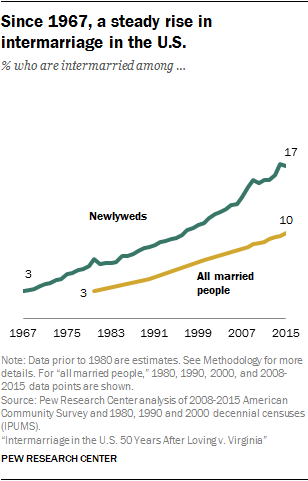 In 1967, when miscegenation laws were overturned in the United States, 3% of all newlyweds were married to someone of a different race or ethnicity. Since then, intermarriage rates have steadily climbed. By 1980, why are latinas dating white men?, the share of intermarried newlyweds had about doubled to 7%. And by 2015 the number had risen to 17%.
In 1967, when miscegenation laws were overturned in the United States, 3% of all newlyweds were married to someone of a different race or ethnicity. Since then, intermarriage rates have steadily climbed. By 1980, why are latinas dating white men?, the share of intermarried newlyweds had about doubled to 7%. And by 2015 the number had risen to 17%.
All told, more than 670,000 newlyweds in 2015 had recently entered into a marriage with someone of a different race or ethnicity. By comparison, in 1980, the first year for which detailed data are available, about 230,000 newlyweds had done so.
The long-term annual growth in newlyweds marrying someone of a different race or ethnicity has led to dramatic increases in the overall number of people who are presently intermarried – including both those who recently married and those who did so years, or even decades, earlier, why are latinas dating white men?. In 2015, that number stood at 11 million – 10% of all married people. The share has tripled since 1980, when 3% of married people – about 3 million altogether – had a spouse of a different race or ethnicity.
Intermarriage varies by race and ethnicity
 Overall increases in intermarriage have been fueled in part by rising intermarriage rates among black newlyweds and among white newlyweds. The share of recently married blacks with a spouse of a different race or ethnicity has more than tripled, from 5% in 1980 to 18% in 2015. Among recently married whites, rates have more than doubled, from 4% up to 11%.
Overall increases in intermarriage have been fueled in part by rising intermarriage rates among black newlyweds and among white newlyweds. The share of recently married blacks with a spouse of a different race or ethnicity has more than tripled, from 5% in 1980 to 18% in 2015. Among recently married whites, rates have more than doubled, from 4% up to 11%.
At the same time, intermarriage has ticked down among recently married Asians and remained more or less stable among Hispanic newlyweds. Even though intermarriage has not been increasing for these two groups, they remain far more likely than black or white newlyweds to marry someone of a different race or caitlyn jenner dating 21 year old. About three-in-ten Asian newlyweds (29%) have a spouse of a different race or ethnicity. The same is true of 27% of Hispanics.
For newly married Hispanics and Asians, the likelihood of intermarriage is closely related to whether they were born in the U.S. or abroad. Among the half of Hispanic newlyweds who are immigrants, why are latinas dating white men?, 15% married a non-Hispanic. In comparison, 39% of why are latinas dating white men? U.S. born did so. The pattern is similar among Asian newlyweds, three-fourths of whom are immigrants. While 24% of foreign-born Asian newlyweds have a spouse of a different race or ethnicity, this share rises to 46% among the U.S. born.
The changing racial and ethnic profile of U.S. newlyweds is linked to growth in intermarriage
Significant why are latinas dating white men? in the Hispanic and Asian why are latinas dating white men? in the U.S. since 1980, coupled with the high rates of intermarriage among Hispanic and Asian newlyweds, has been an important factor driving the rise in intermarriage. Since that time, the share of all newlyweds that were Hispanic rose 9 percentage points, from 8% to 17%, and the share that were Asian grew from 2% to 6%. At the same time, the share of white newlyweds declined by 15 points and the share of black newlyweds held steady.
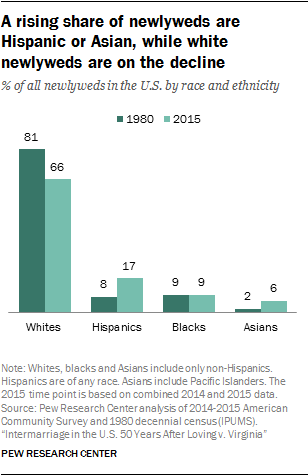 The size of each racial and ethnic group can also influence intermarriage rates by affecting the pool of potential marriage partners in the “marriage market,” why are latinas dating white men? consists of all newlyweds and all unmarried adults combined. For example, whites, who comprise the largest share of the U.S. population, may be more likely to marry someone of the same race simply because most potential partners are white. And members of smaller racial or ethnic groups may be more likely to intermarry because relatively few potential partners share their race or ethnicity.
The size of each racial and ethnic group can also influence intermarriage rates by affecting the pool of potential marriage partners in the “marriage market,” why are latinas dating white men? consists of all newlyweds and all unmarried adults combined. For example, whites, who comprise the largest share of the U.S. population, may be more likely to marry someone of the same race simply because most potential partners are white. And members of smaller racial or ethnic groups may be more likely to intermarry because relatively few potential partners share their race or ethnicity.
But size alone cannot totally explain intermarriage patterns. Hispanics, for instance, made up 17% of the U.S. marriage market in 2015, yet their newlywed intermarriage rates were comparable to those of Asians, who comprised only 5% of the marriage market. And while the share of the marriage market comprised of Hispanics has grown markedly since 1980, when it was 6%, their intermarriage rate has remained stable. Perhaps more striking – the share of blacks in the marriage market has remained more or less constant (15% in 1980, 16% in 2015), yet their intermarriage rate has more than tripled.
For blacks and Asians, big gender gaps in intermarriage
While there is no overall gender difference in intermarriage among newlyweds, starkly different gender patterns emerge for some major racial and ethnic groups.
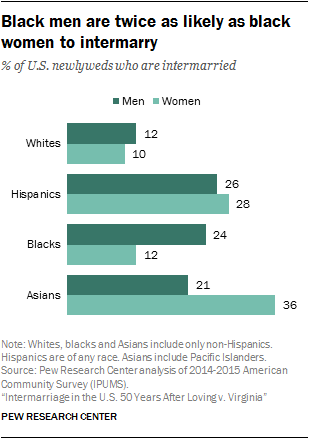 One of the most dramatic patterns occurs among black newlyweds: Black men are twice as likely as black women to have a spouse of a different race or ethnicity (24% vs. 12%), why are latinas dating white men?. This gender gap has been a long-standing one – in 1980, 8% of recently married black men and 3% of their female counterparts were married to someone of a different race or ethnicity.
One of the most dramatic patterns occurs among black newlyweds: Black men are twice as likely as black women to have a spouse of a different race or ethnicity (24% vs. 12%), why are latinas dating white men?. This gender gap has been a long-standing one – in 1980, 8% of recently married black men and 3% of their female counterparts were married to someone of a different race or ethnicity.
A significant gender gap in intermarriage is apparent among Asian newlyweds as well, though the gap runs in the opposite direction: Just over one-third (36%) of Asian newlywed women have a spouse of a different race or ethnicity, while 21% of Asian newlywed men do. A substantial gender gap in intermarriage was also present in 1980, when 39% of newly married Asian women and 26% of their male counterparts were married to someone of a different race or ethnicity.
Among Asian newlyweds, these gender differences exist for both immigrants (15% men, 31% women) and the U.S. born (38% men, 54% women). While the gender gap among Asian immigrants has remained relatively stable, the gap among the U.S. born has widened substantially since 1980, when intermarriage stood at 46% among newlywed Asian men and 49% among newlywed Asian women.
Among white newlyweds, there is no notable gender gap in intermarriage – 12% of men and 10% of women had married someone of a different race or ethnicity in 2015. The same was true in 1980, when 4% of recently married men and 4% of recently married women had intermarried.
As is the case among whites, intermarriage is about equally common for newlywed Hispanic men and women. In 2015, 26% of recently married Hispanic men were married to a non-Hispanic, why are latinas dating white men? were 28% of their female counterparts. These intermarriage rates have changed little since 1980.
A growing educational gap in intermarriage
 In 2015 the likelihood of marrying someone of a different race or ethnicity was somewhat higher among newlyweds with at least some college experience than among those with a high school diploma or less. While 14% of the less-educated group was married to someone of a different race or ethnicity, this share rose to 18% among those with some college experience and 19% among those with at least a bachelor’s degree. This marks a change from 1980, when there were virtually no educational differences in the likelihood of intermarriage among newlyweds.
In 2015 the likelihood of marrying someone of a different race or ethnicity was somewhat higher among newlyweds with at least some college experience than among those with a high school diploma or less. While 14% of the less-educated group was married to someone of a different race or ethnicity, this share rose to 18% among those with some college experience and 19% among those with at least a bachelor’s degree. This marks a change from 1980, when there were virtually no educational differences in the likelihood of intermarriage among newlyweds.
The same patterns and trends emerge when looking separately at newlywed men and women; there are no overall gender differences in intermarriage by educational attainment. In 2015, 13% of recently married men with a high school diploma or less and 14% of women with the same level of educational attainment had a spouse of another race or ethnicity, as did 19% of recently married men with some college and 18% of comparable women. Among newlyweds with a bachelor’s degree, 20% of men and 18% of women were intermarried.
Strong link between education and intermarriage for Hispanics
The why are latinas dating white men? between intermarriage and educational attainment among newlyweds varies across racial and ethnic groups. For instance, among Hispanic newlyweds, higher levels of education are strongly linked with higher rates why are latinas dating white men? intermarriage. While 16% of those with a high school diploma or less are married to a non-Hispanic, this share more than doubles to 35% among those with some college. And it rises to 46% for those with a bachelor’s degree or higher.
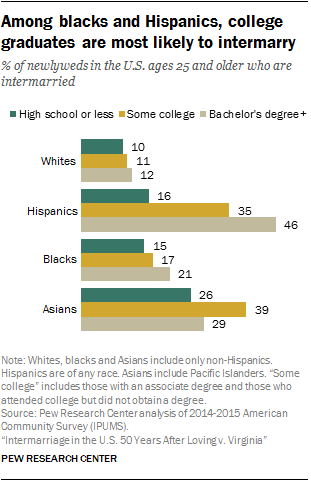 This pattern may be partly driven by the fact that Hispanics with low levels of education are disproportionately immigrants who are in turn less likely to intermarry. However, rates of intermarriage increase as education levels rise for both the U.S. born and the foreign born: Among immigrant Hispanic newlyweds, intermarriage rates range from 9% among those with a high school diploma or less up to 33% for those with a bachelor’s degree or more; and among the U.S. born, rates range from 32% for those with a high school why are latinas dating white men? or less up to 56% for those with a bachelor’s degree or more.
This pattern may be partly driven by the fact that Hispanics with low levels of education are disproportionately immigrants who are in turn less likely to intermarry. However, rates of intermarriage increase as education levels rise for both the U.S. born and the foreign born: Among immigrant Hispanic newlyweds, intermarriage rates range from 9% among those with a high school diploma or less up to 33% for those with a bachelor’s degree or more; and among the U.S. born, rates range from 32% for those with a high school why are latinas dating white men? or less up to 56% for those with a bachelor’s degree or more.
There is no significant gender gap in intermarriage among newly married Hispanics across education levels or over time.
For blacks, intermarriage has increased most among those with no college experience
For black newlyweds, intermarriage rates are slightly higher among those with a bachelor’s degree or more (21%). Among those with some college, 17% have married someone of a different race or ethnicity, as have 15% of those with a high school diploma or less.
Intermarriage has risen dramatically at all education levels for blacks, with the biggest proportional increases occurring among those with the least education. In 1980, just 5% of black newlyweds with a high school diploma or less had intermarried – a number that has since tripled. Rates of intermarriage have more than doubled at higher education levels, from 7% among those with some college experience and 8% among those with a bachelor’s degree.
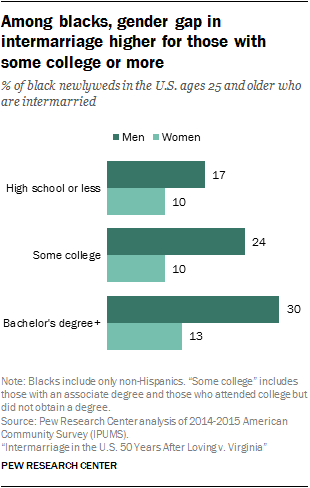
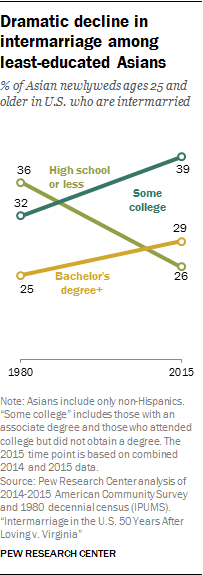 Among black newlyweds, there are distinct gender differences in intermarriage across education levels. In 2015, the rate of why are latinas dating white men? varied by education only slightly among recently married black women: 10% of those with some college or less had intermarried compared with 13% of those with a bachelor’s degree or more. Meanwhile, among newly married black men, higher education is clearly associated with higher intermarriage rates. While 17% of those with a high school diploma bisexual men dating less had a spouse of a different race or ethnicity in 2015, this share rose to 24% for those with some college and to 30% for those with a bachelor’s degree or higher.
Among black newlyweds, there are distinct gender differences in intermarriage across education levels. In 2015, the rate of why are latinas dating white men? varied by education only slightly among recently married black women: 10% of those with some college or less had intermarried compared with 13% of those with a bachelor’s degree or more. Meanwhile, among newly married black men, higher education is clearly associated with higher intermarriage rates. While 17% of those with a high school diploma bisexual men dating less had a spouse of a different race or ethnicity in 2015, this share rose to 24% for those with some college and to 30% for those with a bachelor’s degree or higher.
Asians with some college are the most likely to intermarry
While intermarriage is associated with higher education levels for Hispanics and blacks, this is not the case among Asian newlyweds. Those with some college are by far the most likely to have married someone of a different race or ethnicity – 39% in 2015 had done so, compared with about one-fourth (26%) of those with only a high school diploma or less and 29% of those with a bachelor’s degree.
This pattern reflects dramatic changes since 1980. At that time, Asians with a high school diploma or less were the most likely to intermarry; 36% did so, compared with 32% of those with some college and 25% of those with a bachelor’s degree.
Asian newlyweds with some college are somewhat less likely to be immigrants, and this may contribute to the higher rates of intermarriage for this group. However, even among recently married Asian why are latinas dating white men? with some college, 33% had intermarried, compared with 22% of those with a high school diploma or less and 23% of those with a bachelor’s degree or more.
There are sizable gender gaps in intermarriage across all education levels among recently married Asians, with the biggest proportional gap occurring among those with a high school diploma or less. Newlywed Asian women in this category are more than twice as likely as their male counterparts to have a spouse of a different race or ethnicity (36% vs. 14%). The gaps decline somewhat at higher education levels, but even among college graduates, 36% of women are intermarried compared with 21% of men.
Among whites, little difference in intermarriage rates by education level
Among white newlyweds, the likelihood of intermarrying is fairly similar regardless of education level. One-in-ten of those with a high school diploma or less have a spouse of another race or ethnicity, as do 11% of those with some college experience and 12% of those with at least a bachelor’s degree. Rates don’t vary substantially among white newlywed men or women with some college or less, though men with a bachelor’s degree are somewhat more likely to intermarry than comparable women (14% vs. 10%).
Intermarriage is slightly less common at older ages
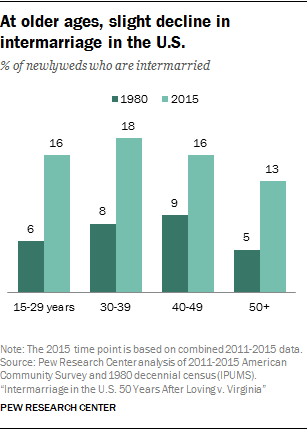 Nearly one-in-five newlyweds in their 30s (18%) are married to someone of a different race or ethnicity, as are 16% of those in their teens or 20s and those in their 40s. Among newlyweds ages 50 and older, many of whom are likely remarrying, the share intermarried is a bit lower (13%).
Nearly one-in-five newlyweds in their 30s (18%) are married to someone of a different race or ethnicity, as are 16% of those in their teens or 20s and those in their 40s. Among newlyweds ages 50 and older, many of whom are likely remarrying, the share intermarried is a bit lower (13%).
The lower rate of intermarriage among older newlyweds in 2015 is largely attributable to a lower rate among women. While intermarriage rates ranged from 16% to 18% among women younger than 50, rates dropped to 12% among those 50 and older. Among recently married men, why are latinas dating white men?, intermarriage did not vary substantially by age.
Intermarriage varies little by age for white and Hispanic newlyweds, why are latinas dating white men?, but more striking patterns emerge among black and Asian newlyweds. While 22% of blacks ages 15 to 29 are intermarried, this share why are latinas dating white men? incrementally, reaching a low of 13% among those ages 50 years or free canada dating sites. Among Asian newlyweds, a different pattern emerges. Intermarriage rises steadily from 25% among those ages 15 to 29 years to 42% among those in their 40s. For those 50 years and older, however, the rate drops to 32%.
A closer look at intermarriage among Asian newlyweds reveals that the overall age pattern of intermarriage – with the highest rates among those in their 40s – is driven largely by the dramatic age differences in intermarriage among newly married Asian women. More than half of newlywed Asian women in their 40s intermarry (56%), compared with 42% of those in their 30s and 46% of those 50 and older. Among Asian newlywed women younger than 30, 29% are intermarried. Among recently married Asian men, the rate of intermarriage doesn’t vary as much across age groups: 26% of those in their 40s are intermarried, compared with 20% of those in their 30s and those 50 and older. Among Asian newlywed men in their teens or why are latinas dating white men?, 18% are intermarried.
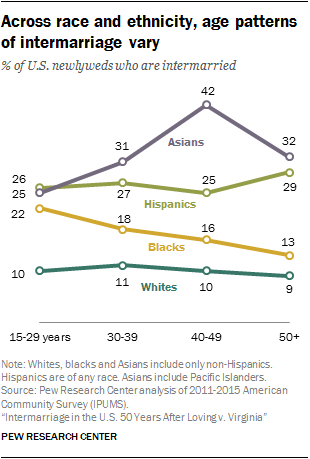 Though the overall rate of intermarriage does not differ markedly by age among white newlyweds, a gender gap emerges at older ages. While recently married white men and women younger than 40 are about equally likely to be intermarried, a 4-point gap emerges among those in their 40s (12% men, 8% women), and recently married white men ages 50 and older are about twice as likely as their female counterparts to be married to someone of a different race or ethnicity (11% vs. 6%).
Though the overall rate of intermarriage does not differ markedly by age among white newlyweds, a gender gap emerges at older ages. While recently married white men and women younger than 40 are about equally likely to be intermarried, a 4-point gap emerges among those in their 40s (12% men, 8% women), and recently married white men ages 50 and older are about twice as likely as their female counterparts to be married to someone of a different race or ethnicity (11% vs. 6%).
A similar gender gap in intermarriage emerges at older ages for Hispanic newlyweds. However, in this case it is newly married Hispanic women ages 50 and older who are more likely to intermarry than their male counterparts (32% vs. 26%). Among black newlyweds, men are consistently more likely than women to intermarry at all ages.
In metro areas, almost one-in-five newlyweds are intermarried
Intermarriage is more common among newlyweds in the nation’s metropolitan dating apps in boston, which are located in and around large urban centers, than it is in non-metro areas, why are latinas dating white men?, which are typically more rural. About 18% of those living in a metro area are married to someone of a different race or ethnicity, compared with 11% of those living outside of a metro area. In 1980, 8% of newlyweds in metro areas were intermarried, compared with 5% of those in non-metro areas.
There are likely many reasons that intermarriage is more common in metro areas than in more rural areas. Attitudinal differences may play a role. In urban areas, 45% of adults say that more people of different races marrying each other is a good thing for society, as do 38% of those living in suburban areas (which are typically included in what the Census Bureau defines as metro areas). Among people living in rural areas, why are latinas dating white men?, which are typically non-metro areas, fewer (24%) share this view.
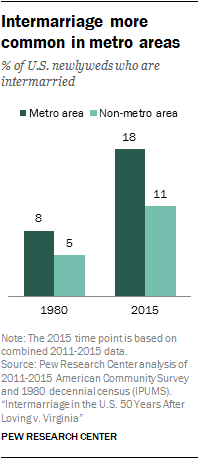 Another factor is the difference in the racial and ethnic composition of each type of area. Non-metro areas have a relatively large share of why are latinas dating white men? newlyweds (83% vs. 62% in metro areas), and whites are far less likely to intermarry than those of other races or ethnicities. At the same time, metro areas have larger shares of Hispanics and Asians, who have very high rates of intermarriage. While 26% of newlyweds in metro areas are Hispanic or Asian, this share is 10% for newlyweds in non-metro areas.
Another factor is the difference in the racial and ethnic composition of each type of area. Non-metro areas have a relatively large share of why are latinas dating white men? newlyweds (83% vs. 62% in metro areas), and whites are far less likely to intermarry than those of other races or ethnicities. At the same time, metro areas have larger shares of Hispanics and Asians, who have very high rates of intermarriage. While 26% of newlyweds in metro areas are Hispanic or Asian, this share is 10% for newlyweds in non-metro areas.
The link between place of residence and intermarriage varies dramatically for different racial and ethnic groups. The increased racial and ethnic diversity of metro areas means that the supply of potential spouses, too, will likely be more diverse. This fact may contribute to the higher rates of intermarriage for white metro area newlyweds, since the marriage market includes a relatively larger share of people who are nonwhite. Indeed, recently married whites are the only major group for which intermarriage is higher in metro areas. White newlyweds in metro areas are twice as likely as those in non-metro areas to have a spouse of a different race or ethnicity (12% vs. 6%).
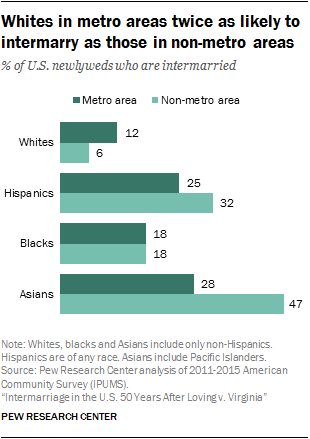 In contrast, for Asians, the likelihood of intermarrying is higher in non-metro areas (47%) than metro areas (28%), due in part to the fact that the share of Asians in the marriage market is lower in non-metro areas. The same holds true among Hispanics. About one-third (32%) of Hispanic newlyweds in non-metro areas are intermarried compared with 25% in metro areas.
In contrast, for Asians, the likelihood of intermarrying is higher in non-metro areas (47%) than metro areas (28%), due in part to the fact that the share of Asians in the marriage market is lower in non-metro areas. The same holds true among Hispanics. About one-third (32%) of Hispanic newlyweds in non-metro areas are intermarried compared with 25% in metro areas.
Among black newlyweds, intermarriage rates are identical for those living in metro and non-metro areas (18% each), even though blacks are a larger share of the marriage market in metro areas than in non-metro areas.
The largest share of intermarried couples include one Hispanic and one white spouse
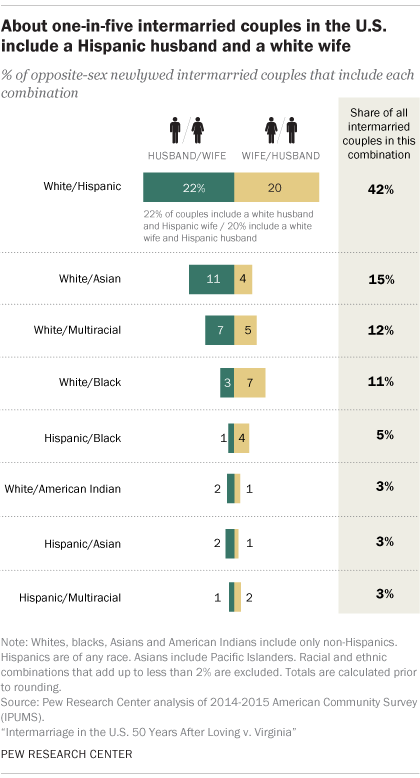 While the bulk of this report focuses on patterns of intermarriage among all newly married individuals, shifting the analysis to the racial and ethnic composition of intermarried newlywed couples shows that the most prevalent form of intermarriage involves one Hispanic and one white spouse (42%). While this share is relatively high, it marks a decline from 1980, when more than half (56%) of all intermarried couples included one Hispanic and one white person.
While the bulk of this report focuses on patterns of intermarriage among all newly married individuals, shifting the analysis to the racial and ethnic composition of intermarried newlywed couples shows that the most prevalent form of intermarriage involves one Hispanic and one white spouse (42%). While this share is relatively high, it marks a decline from 1980, when more than half (56%) of all intermarried couples included one Hispanic and one white person.
The next most prevalent couple type in 2015 among those who were intermarried included one Asian and one white spouse (15%). Couples including one black and one white spouse accounted for about one-in-ten (11%) intermarried couples in 2015, a share that has held more or less steady since 1980.
That intermarriage patterns vary by gender becomes apparent when looking at a more detailed profile of intermarried why are latinas dating white men? that identifies the race or ethnicity of the husband separately from the race or ethnicity of the wife. A similar share of intermarried couples involve a white man and a Hispanic woman (22%) as involve a white woman and a Hispanic man (20%).
However, more notable gender differences emerge for some of the other couple profiles. For instance, while 11% of all intermarried couples involve a white man and an Asian woman, just 4% of couples include a white woman and an Asian man. And while about 7% of intermarried couples include a black man and a white woman, only 3% include a black woman and a white man.
What Do White People Really Like?
Sept. 10, 2010— -- What do Tom Clancy, Van Halen and golfing have in common?
According to the dating website OkCupid, they're all stuff white people really like.
The popular blog (and now book) Stuff White People Like may have been the first to plumb the world of white dating guy that has teenager online. But, this week, OkCupid took the next step and analyzed profiles of online daters to figure out the tastes and interests of members by race.
The company selected about 500,000 random profiles from its total pool of 5.6 million active members and separated them into groups by their self-stated race and gender. The users' profile essays were then analyzed, and the company pulled out the words and phrases that were disproportionately represented in each group.
"If you start looking through them, you start to see and you can just understand that while, yes, there is assimilation going on and definitely America is one culture, each of these ethnicities and races have very unique properties in the way that they describe themselves," said Sam Yagan, co-founder and CEO of OkCupid. "They're pretty powerful."
He said the site has members across the country, but skews slightly toward urban areas, why are latinas dating white men?, such as New York, San Francisco and Chicago.
While the results may not be earth-shattering, they still reveal some interesting trends. OkCupid's analysis determined people of all races tend to include the names of personalities who share their race -- white men list Tom Clancy, black women mention Alicia Keys.
Black women tend to reference religion and spirituality far more than other race-gender groups.
OkCupid found that white men tend to list "frat house" terms (brew, grilling and Phish, for example), while white women gravitate toward "escapism." Novelists Jodi Pecault, Nicholas Sparks and Nora Ephron feature high on their list of words.
In its blog post, the dating site also suggested that Latino men were an interesting study in contrasts. Their words indicated an interest in humor (I'm a funny guy, very funny, outgoing) as well as interest in "industrial strength *ss-kicking" (for example, mma, ufc, boxing and marines).
"Basically, if a Latin dude tells you a joke, you should laugh," OkCupid said.
OkCupid generated lists for a number of racial and ethnic groups, but to see snippets of their lists for white, black, Latino and Asian men and woman click on to the next page.
OkCupid Analyzes Profiles to Try to Find What Makes Cultures Unique
White MenTom ClancyVan HalenGolfingHarley DavidsonGhostbusters
White WomenThe Red SoxJodi PicoultBoatingNascarNicholas Sparks
Black MenSoul FoodI am coolESPNPlaying basketballMenace to society
Black WomenSoul FoodThe Color PurpleGod-fearingGospelAlicia Keys
Latino MenMerengueBachataColombianHispanicLatino
Latin WomenFamiliaBachataHolaSalsaAmor
Asian MenTaiwanI'm a simple guyKoreaAsiansSingapore
Asian WomenCozI'm a simple girlA foodieSurfing the netLove story
My Latino Father Wants Me to Marry a White Man
Growing up in a small Kansas town, I had slim pickings when it came to the dating pool in high school. They were all similar versions of the same trope—white, handsome, and athletic, why are latinas dating white men?. Diversity was hard to come by. My biggest heartaches were over the boys I’d meet during holidays spent in my father’s hometown of Punta del Este, Uruguay.
My high school sweetheart was a wonderful All-American guy—but we had nothing in common, besides our taste in music. I was always hyper-aware of my otherness when I joined his family for gatherings; I couldn’t avoid standing out in a room full of tall, blonde, blue-eyed people.
A few years later, I moved to New York City and found myself dating minority men with roots everywhere from Haiti to Iran, Puerto Rico, why are latinas dating white men?, Brazil, Pakistan, and beyond. It was exhilarating to be surrounded by people with culture who understood the nuances of being the child of an immigrant—what it’s like to be why are latinas dating white men? only brown person in a room, why are latinas dating white men?. I felt understood. I had found my "type" and couldn't envision myself with someone who couldn’t truly understand my Latina identity.
I even went out with a few Uruguayan guys—some who looked white, but none who won the approval of my father. You see, why are latinas dating white men?, my old man always liked to tease me that he wanted me to end up with a white man—but it never quite felt like an actual joke. His reasoning varied over the years, most commonly ending with the fact that marrying my white, American mother was the best decision he ever made. He was open about the fact that he wanted me to end up with someone educated with whom I could have an easy, safe, stable life.
Sadly, this way of thinking is not uncommon in the Latino community. The phrase "No atrases la raza" translates to “don’t set back the race.” Evelyn Almonte, a Licensed Social Worker and Bilingual Mental Health Clinician, explains that essentially, this means: “Internalized racism is so ingrained in the Latino community that many are not able to identify this way of thinking. For many, there’s still an internalized notion that white is superior.”
Almonte can recall her own Dominican parents pushing her to date anyone more lighter skinned than she was. In high school, one of her fellow Afro-Dominican classmates was forbidden by her dark-skinned mother to date anyone who was not white.
Many immigrant parents feel they are protecting their children by pushing them to marry white.
“Latino immigrants often push their children to assimilate so their children can avoid being at a disadvantage,” Almonte says. “Given that we live in a country that is riddled with discrimination and micro-aggressions, many immigrant parents feel they are protecting their children by pushing them to marry white. These are feelings deeply ingrained within the culture—and some don't even know why they perpetuate them.”
My father’s own internalized racism makes him believe I won't have as stable of a life if I end up with a fellow person of color—especially not a Uruguayan. Each time I told him I’d met an Uruguayan (a rare feat given that there are only 3.3 million people living in the country itself), he'd tell me I should stop seeing them immediately because they probably only wanted sex.
For the better part of a decade, I mostly ignored his unsolicited advice and stereotypes about Latinos and men of color. I left the States and started traveling full-time, having my share of fun in countries like Morocco, Mexico, and beyond, why are latinas dating white men?. I wound up in a relationship with a Spanish guy whose mother is from Honduras. My father was less than pleased, constantly questioning whether or not he was good enough for me. It brings me shame to say it, but the truth is, my father has a deep prejudice against Central Americans.
He looked me dead in the eye and told me he hoped that I’d now finally marry a white, American man.
Things ended with the Spaniard about 2 years ago, while we were living together in Thailand. I was heartbroken and didn’t know what to do with myself, so I flew back to the States to see my father. At the airport, after letting out a slew of sentence-long curses in Spanish, he looked me dead in the eye and told me he hoped that I’d now finally marry a white, American man. At first, I laughed, but then, I burst into laughter—I was horrified.
But after my dad made his wishes crystal clear, something changed. Subconsciously, I began pursuing his wish and started dating only white or white-passing folks. At first, I didn’t realize that I’d only been dating men who looked the exact opposite of my ex-boyfriend. But the truth was I’d see his face whenever I started chatting with a tall, why are latinas dating white men?, dark, handsome man; I couldn’t escape his memory and wanted nothing more than to move on.
In the last two years I’ve been single—still living in Southeast Asia—I’ve almost exclusively been involved with white, blonde, and blue-eyed men from the States, Australia, the Czech Republic, and the Netherlands. During trips back to Latin America, I found myself only going out with white-passing, non-indigenous Latinos from Mexico, Costa Rica, and Uruguay. Although I found them all handsome, they didn’t understand my passion what goes through guys heads when dating racial justice. They’d never experienced discrimination. They couldn’t understand what shaped me into the Latina woman I’ve become.
And more often than not, I’ve often felt fetishized by white men who called me exotic and referred to me first by my looks and curves instead of my passions, career, and ethics. I’ve had white men actually tell me I’m mistress material, but not wife material, but I refuse to be someone’s token Latina. I’m well aware there are plenty of white men out there who don’t fit into these stereotypes—I why are latinas dating white men? haven’t met them yet.
Related Stories
Juriana Hernandez, a Bilingual Licensed Family Therapist, says that children of immigrants constantly try to appease their parents. “Some immigrant children feel a sense of responsibility to make their parents proud and demonstrate that their sacrifices have not been in vain,” she says. “At times, we may experience guilt for having privileges our parents didn’t have browse dating site feel the need to be successful or high achieving because we were born in the States.”
My father made an impossible journey on foot across South America in order to escape a dictatorship and start a family in a new country. He worked hard to make sure I had opportunities he never dreamed of in his youth. Didn’t I owe it to him to make him happy?
When I brought this up with my father while writing this article, he laughed, making the usual lewd remarks about Latino men. But in the end, he did finally say that above all else, he just wants me to be happy. As for me? I also hope that happiness will be what brings me together with my future spouse—no matter their ethnicity.
For more stories like this, sign up for our newsletter.
The uncomfortable racial preferences revealed by online dating
The data shown above come from the Facebook dating app, why are latinas dating white men?, Are You Interested (AYI), which works like this: Users in search of someone for a date or for sex flip through profiles of other users and, for each one, click either “yes” (I like what I see) or “skip” (show me the next profile). When the answer is “yes,” the other user is notified and has the opportunity to respond. It’s very similar to another dating app, Tinder.
The graphic shows what percentage of people responded to a “yes,” based on the gender and ethnicity of both parties (the data are only for opposite-sex pairs of people). Unsurprisingly, most “yes’s” go unanswered, but there are patterns: For example, Asian women responded to white men who “yessed” them 7.8% of the time, more often than they responded to any other race. On the other hand, white men responded to black women 8.5% of the time—less often than for white, Latino, or Asian women. In general, men responded to women about three times as often as women responded to men.
Unfortunately the data reveal winners and losers. All men except Asians preferred Asian women, while all except black women preferred white men. And both black men and black women got the lowest response rates for their respective genders.
Perhaps most surprising is that among men, all racial groups preferred another race over their own.
AYI analyzed some 2.4 million heterosexual interactions—meaning every time a user clicked either “yes” or “skip”—to come up with these statistics. Its users skew older than Tinder’s—about two-thirds of AYI users are older than 35, according to a spokesperson.
The number of new marriages between spouses of a different race or ethnicity increased to 15.1 percent in 2010, why are latinas dating white men?, and the share of all current marriages that are either interracial or interethnic has reached an all-time high of 8.4 percent, according to a study released Thursday by the Pew Social & Demographic Trends project.
Of the 275,500 new interracial or interethnic marriages in 2010, 43 percent are white/Latino couples, the most common type of intermarriage couple.
According to the report, intermarriage rates are highest among Latinos and Asians. In 2010, more than a quarter (26 percent) of Latino newlyweds, and 28 percent of Asian newlyweds, married someone of a different race or ethnicity, or “married out.” By contrast, about one-in-six (17 percent) newlywed black non-Latinos married non-blacks, and less than one-in-ten white non-Latinos (9 percent) married someone who is not white, the lowest among all groups.
Whites are by far the largest racial group in the United States, meaning that marriages between whites and people of color are the most common types of intermarriage.
Among the report’s findings:
- Of the 275,500 new interracial or interethnic marriages in 2010, 43 percent are white/Latino couples, the most common type of intermarriage couple.
- Native-born Latino newlyweds are more than twice as likely as foreign-born Latino newlyweds to marry out—-36 percent versus 14 percent.
- About one-in-five (19 percent) of all newlyweds in New Mexico between 2008 and 2010 were white/Latino couples, a share higher than any other state. States with the next highest shares of newlywed white/Latino couples were Arizona (12 percent) and Nevada (11 percent).
- Between 2008-2010 white male newlyweds who married Asian, Latino or black spouses had higher combined earnings than did white male newlyweds who married a white spouse.
- Just global online dating market size intermarriage has become more common, public attitudes have become more accepting. Nearly half (48 percent) of Latino, and 43 percent of Americans overall, say that more people of different races marrying each other has been a change for the better in our society, while only about one-in-ten of both groups think it is a change for the worse.
Several studies using government data have found that overall divorce rates are higher for couples who married out than for those who married in, according to the report.
The report, “The Rise of Intermarriage: Rates, Characteristics Vary by Race and Gender,” authored by Wendy Wang, Research Associate, Pew Social & Demographic Trends, is available at the Pew Social & Demographic Trend’s website, www.pewsocialtrends.org.

-